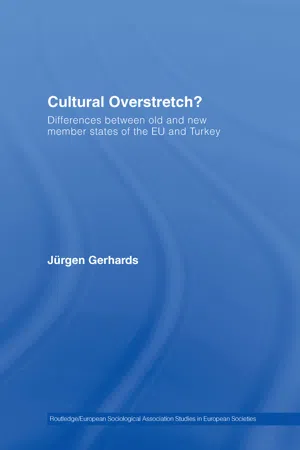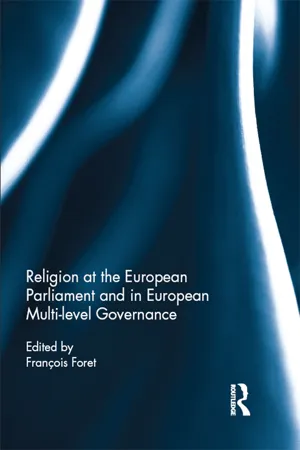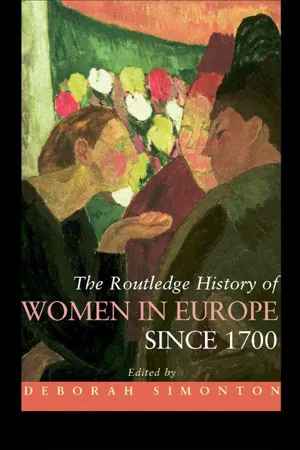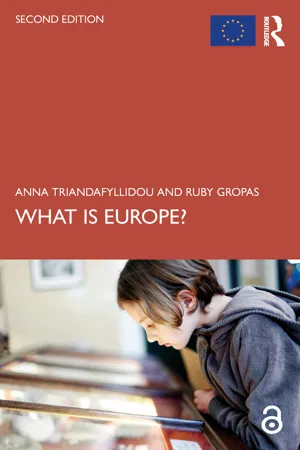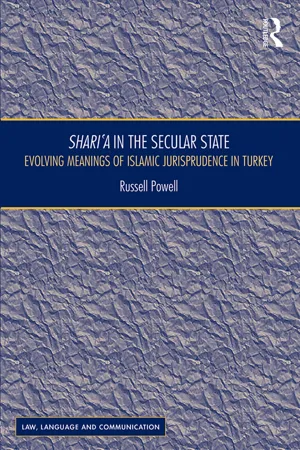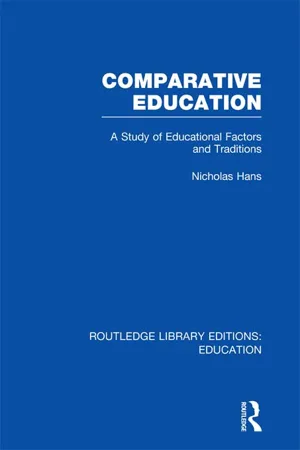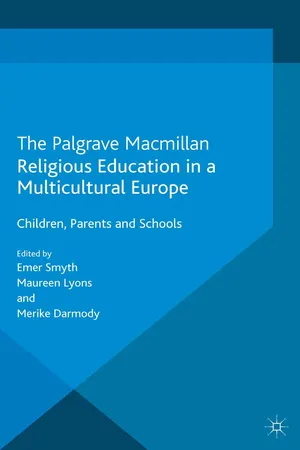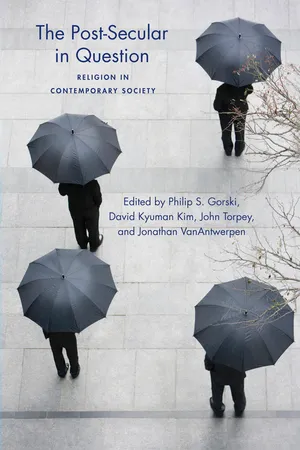History
Religion in Europe
Religion in Europe has played a significant role in shaping the continent's history and culture. Christianity, particularly Catholicism and Protestantism, has been the dominant religion, influencing politics, art, and social structures. The Reformation and Counter-Reformation were pivotal moments in European religious history, leading to religious conflicts and the rise of religious diversity in the region.
Written by Perlego with AI-assistance
Related key terms
11 Key excerpts on "Religion in Europe"
- eBook - ePub
Religion and Society at the Dawn of Modern Europe
Christianity Transformed, 1750-1850
- Rudolf Schlögl, Helen Imhoff, Brian Cowan, Beat Kümin(Authors)
- 2020(Publication Date)
- Bloomsbury Academic(Publisher)
Introduction: Religion as a System within SocietyThe period from 1750 to 1850 was marked by profound social changes in central and western Europe, affecting political institutions as well as the basic processes by which society was formed.1 The emancipation of the British colonies in America and their new constitution served as a trigger for similar upheaval in Europe: the institutional structures of the ancien régime were swept away in a revolution and two decades of wars between different states, from which a new ‘civil’ society emerged, developing its own political and social institutions to replace the old feudal structures. There were two ways in which European Christendom was involved in this upheaval and the subsequent attempts to develop new forms of social and political organization: on the one hand, the changes in social structures and hierarchies had profound consequences for the social forms of Christianity; on the other hand, European Christianity, in turn, also played a large role in reshaping society and its institutions. It is this transformation of the social aspects of European Christianity that is the subject of this book.2Thus I am not concerned with the history of the individual churches in Europe,3 but with the history of Christianity as a system within European society at the beginning of the modern age. This approach has two implications: society must be understood as more than just a community structured as a state, and religion must be understood as a social phenomenon, which can only be adequately grasped within the context of social structures. Anyone researching this topic will find that there is a multitude of individual studies on the early churches and on the history of personal piety as well as much discussion on religion. This body of secondary literature, however, is of little assistance when considering the approach outlined above.4 - eBook - ePub
The Social Significance of Religion in the Enlarged Europe
Secularization, Individualization and Pluralization
- Olaf Müller, Detlef Pollack(Authors)
- 2016(Publication Date)
- Routledge(Publisher)
Chapter 1Church and Religion in the Enlarged Europe: Analyses of the Social Significance of Religion in East and West
Detlef Pollack, Olaf Müller and Gert PickelThe Initial Question: Religion in Modern Europe
Religion and church continue to have a marked significance in European countries at the end of the twentieth and the beginning of the twenty-first century. A glance at the events surrounding the disintegration of the Yugoslavian multinational state, the conflicts that repeatedly flare up in Northern Ireland, and the integration problems of Muslim immigrants in countries like France, Great Britain, Denmark, the Netherlands and Germany, makes it clear that beside language, history and nationality, religion also represents an active force that can assume both a unifying and a divisive character. Especially since the terrorist attack on the World Trade Center in New York, religion has become a topic of public debate, and media attention on the topic of religion has increased. As of that point, the issue of religious conflicts has not disappeared from the agenda, and religion often seems to have taken the place of discussions that were formerly political and national in character. If the discussion between the Western and Eastern power blocs were decisive for public debate and the view of international conflicts until 1989, religious affiliations and identities now appear to have taken over as the central explanatory factor behind conflicts that transcend nations and cultures. One need not go as far as Samuel Huntington (1996), who interpreted the central international conflicts at the end of the Cold War as a religiously coloured clash of civilizations, in order to agree with the view that to a greater extent than in previous decades religion has become a decisive category for the perception and interpretation of political, economic and social processes and differences. The increase in the significance of religious factors for the explanation and interpretation of social, political, and international conflicts and changes also applies to Europe, which has changed greatly as a result of the collapse of state socialism and the re-entry of Eastern and East Central European countries into European history. In particular, the increased status in Eastern Europe of national churches, religious movements, and ethnic conflicts within the religious sphere is obvious. - eBook - ePub
Cultural Overstretch?
Differences Between Old and New Member States of the EU and Turkey
- Jurgen Gerhards(Author)
- 2007(Publication Date)
- Routledge(Publisher)
2 Religion in a wider EuropeReligion strongly influences people’s behavior and is a central element in societal culture. The influence of religion is evident through directly related actions such as: praying, attending church, eating particular foods or the way the calendar year is arranged. Religious orientations also influence non-religious activities, such as: voting behavior, economic behavior and moral attitudes toward questions, e.g. abortion and homosexuality (Pickel 2001). They can provoke conflicts and even civil wars, such as those between Muslims and Hindus in India and Pakistan, between Catholics and Protestants in Northern Ireland, and the continuing tensions in the Balkans. The United States is an example of a modernized country in which this strong relationship between religion and politics holds true: American presidents typically end their public addresses with “God bless America.”1Some political scientists and political actors emphasize the importance of religion for a common European culture (Kallscheuer 1996, Rémond 1998, Zulehner and Denz 1994). For these actors, the central issue surrounding Turkey’s accession into the EU is not economic, but cultural-religious. Those opposing the accession of Turkey try to demonstrate that today’s EU members are, due to completely divergent histories, fundamentally different from Turkish citizens. Paramount among these differences is religious orientation – people in the EU are predominantly Christian, those in Turkey, Muslim. Therefore, Europe and Turkey are not culturally similar enough to be included in the same common Union (Wehler 2002). In drawing the borders of his cultural map of the world, Samuel Huntington (1996) is even stricter about the West. Not only does he exclude Muslims, but also Orthodox Christians. Huntington views the spreading of Protestantism and Catholicism as the central criteria for defining Europe’s border (Huntington 1996:251ff.).2 - François Foret(Author)
- 2018(Publication Date)
- Routledge(Publisher)
The purpose of RelEP is to fill a blank in the knowledge of the cultural profile of European political elites on the one hand, and on the specificity of interactions between religion and politics at the supranational level on the other hand. The organisation of the research reflects this purpose and complies with the constraints of a normative object such as religion, calling for a flexible and adaptative approach.An attempt to fill a gap in the existing scholarshipGod is again in the focus of social sciences. Major theorists of the expected extinction of religion by modernity have reversed their diagnosis and speak now of desecularisation all over the world (Berger 1999). Europe remains the exception (Berger, Davie, and Fokas 2008), with a steady decline of beliefs and practices. Religion does not disappear but mutates into a memory, a ritual provider or ethos (Davie 2002). Faith is less and less regulated by institutions and absolute truth, and more and more an individual relativistic choice. Its political effects persist, but mainly as a diffuse influence or symbolic material (Capelle-Pogacean, Michel, and Pace 2008; Willaime 2004).If spiritual evolutions are well documented by sociologists of religion, linking European integration and religion is not easy for political scientists. Europe is frequently considered more as a civilisational and geographical entity than as a political system (Huntington 1993; Jenkins 2007). As a discipline rooted originally mainly in international relations and political economy with a realist mainstream, European studies has for long been little receptive of such ideational factors as religion, apart from historical or normative approaches (Habermas 2010; Weiler 2003; Weigel 2005) offering inputs in the debate on the Christian heritage of Europe but saying little on its contemporary effects.For a long time, religion was not among the ‘usual suspects’ in European studies, given the interest-driven and functionalist mainstream view in this field. This has changed in the last decade, with a wave of new research by established or new scholars acknowledging the salience of the religious question. The religious issue has become totally congruent with the ‘identity-turn’ recently taken by scholarship on European integration: religion is being rediscovered as a part of collective culture and memory likely to frame policy preferences. The ‘normalisation’ of the EU, which is more and more seen as a polity to be compared to other polities of the past and the present, takes us back to one of the oldest questions of political science: relationships between spiritual and secular powers. To fight the deficit of legitimacy of the EU, many voices call for a politicisation of the bloc in order to organise and solve conflicts in European arenas. If politicisation means searching for controversial issues able to polarise collective preferences and to mobilise coalitions in democratic debates, religion is a likely candidate.- Deborah Simonton, Deborah Simonton(Authors)
- 2006(Publication Date)
- Routledge(Publisher)
Although Christianity has been the dominant European religion since late Roman times, the history of the continent and its several religions is comprehensible only within the context of the wider world. Geographically and historically Europe has been and is increasingly linked with regions far from its borders, and the religions that flourish on European soil are witness to those connections. But the plurality that has resulted has frequently been an agent of difficulty, dissension and strained loyalties. Religion has constituted the major supra-local bond everywhere in Europe, binding together co-religionists and giving to religious adherence and loyalty the ability at times to strengthen and at others to threaten politically imposed boundaries. The resultant persecutions and wars of religion, or wars with strong religious associations, have been a frequent and are still an undiminished element in European experience, as the situations in regions such as the Balkans and Northern Ireland demonstrate only too clearly.The European past and its culture, while deeply rooted in Christian history, has also been enriched by encounters with other religions, and in spite of sporadic tensions has been coloured particularly by contributions from Judaism and Islam. European Jewish communities have a long history. They have frequently suffered the disadvantages and discriminations that attach to minorities – they have been used and abused, valued and persecuted; in some situations they have sought to maintain their ethnic and religious distinctiveness, in others they have found it politic to assimilate to the host population. In modern Europe, such social assimilation only became possible after the emancipation of the Jews and the slow and uneven process of social acceptance.12 The break-up of ‘classical Judaism’ in the eighteenth century meant that many experienced a loosening of ties with the ancient world view that had been fostered by their tradition and were challenged to reconceptualise what it meant to be a Jew. It has been argued that this sometimes painful process permitted the acceptance of Enlightenment ideas of humanity and universality and eventually led to a form of religious modernity that legitimated the adoption of a critical approach to historical sources and, in consequence, permitted questions to be asked about the relationship between the individual Jew’s ethno-religious identity and his or her emerging national identity.13 The forms such questions have taken have inevitably been determined by local circumstances and have resulted in sometimes surprising alliances. In France, for example, in spite of its hostility to religion, many Jews identified with the Revolution that had brought them citizenship. In nineteenth-century Germany many Jews, even if convinced Zionists, were keen to remain loyal to the state while attempting to cling to their ethnic identity; as J. Reinhartz has shown, only a minority were even tempted to go to Palestine until events after 1933 left few other choices open to them.14- eBook - ePub
- Anna Triandafyllidou, Ruby Gropas(Authors)
- 2022(Publication Date)
- Routledge(Publisher)
The second cleavage that permeates a notion of European culture is that of religion versus secularism and the appropriate degrees of the latter for liberal democratic societies in Europe. Thus, while Europe has gradually grown unchurched, the relations between church and state and the role of religion in public life remain contested matters. The tensions in this domain are manifold; they include tension between the Islamic and the Christian religions, but also among the Protestant, the Catholic, and the Orthodox Christian currents, and between the atheist and religious views.A third cleavage that marks European culture is predominantly ideological between the left and the right, between a view that privileges liberalism, individual autonomy, competition, and the pursuit of freedom at all costs, and one that favours a sense of solidarity, community rights, social justice, and social protection. While the distinction may take its more pronounced form in politics, it has important cultural ramifications as it defines social and personal relations, quality of life choices, and views of what a good life is.We argue that, overall, the plurality within the European culture (or European civilisation) develops at two levels. First, Europe can be conceived as an ‘intra-civilisational constellation’, composed of a number of civilisations, which, interestingly, all appear in pairs. We thus speak of the Greco-Roman or the Judeo-Christian, the Byzantine and the Slavic-Orthodox or Slavic and Orthodox traditions. Another version of European culture includes the Jewish diasporic tradition, the plural realities of the Ottoman Empire, and the encounters with contemporary European Islam. Second, Europe includes a transcontinental dimension of inter-civilisational encounters. This approach highlights the influence of the non-European world on the construction of a European culture through opposition or the ‘mirror’ effect. From trade to violent exchanges, colonisation, imperialism, and travel there has been a mixing, an exchange and learning between European and North American, Asian, African, or Latin American civilisations. - eBook - ePub
Shari`a in the Secular State
Evolving Meanings of Islamic Jurisprudence in Turkey
- Russell Powell(Author)
- 2016(Publication Date)
- Routledge(Publisher)
1 Religion in contextFrom the Latin, “religare,” religion refers to “binding back,” usually in the sense of connecting with the divine. However, not all scholarly definitions of religion imply divinity or even spirit. Three of the principal categories of theories defining religion are first, religion in its metaphysical or theological sense (e.g., the underlying truth of the existence of God, the dharma, etc.); second, religion as it is psychologically experienced by people (e.g., the feelings of the religious believer about divinity or ultimate concerns, etc.); and third, religion as a cultural or social force (e.g., symbolism that binds a community together or separates it from other communities). Definitions of religion typically begin by assuming one of these approaches, although some blend aspects of two or three. While understanding the first category, the metaphysical or theological, is important for context and is addressed by the data analyzed in Chapter Five , the qualitative data discussed in Chapters Six and Seven focus on the second and third categories (the personal and the social experiences of religion). This first chapter also addresses the relationship between religion and the state and the idea of secularism, which is explored further in Chapter Four - eBook - ePub
Comparative Education
A Study of Educational Factors and Traditions
- Nicholas Hans(Author)
- 2012(Publication Date)
- Routledge(Publisher)
Of the three great religions—Christianity, Islam and Judaism—which still count their adherents in Europe in millions, only the first became an integral part of European culture. Judaism during the three thousand years of its history has been the religion of a small community isolated from the surrounding population, and has influenced Europe only in so far as the teachings of the Old Testament were incorporated in Christianity. Islam, on the other hand, directly influenced Europe from the two Southern peninsulas, Spain and the Balkans, and has left traces of its impact on Europe in all fields of cultural activity. We shall, therefore, limit our description of religious traditions to Christianity with a short reference to Islam.For a long period the jurisdiction of the Christian Church extended over the whole area within the frontiers of the Roman Empire, and it was, from the time of Constantine onward, a State-supported institution. As the Roman Empire was divided into the Western or Latin-speaking half and the Eastern or Greek-speaking half, so the Church quite naturally used the Latin and Greek languages in these respective territories. The philosophic tendency of the Greeks and the legal precision of the Romans imparted to the two branches of the universal Church characteristic distinctions which were evident even before the official schism. The fall of the Western Roman Empire and its division into many countries ruled by newly converted Teutonic kings made the only Western Patriarch—the Pope of Rome—the natural custodian of the Roman Imperial traditions and in a way the heir of the Roman Emperor. In the Eastern or Byzantine Empire the four Eastern Patriarchs were confronted with the continued centralisation of secular power in the person of the Emperor, and thus were not able to acquire the prestige and independence which were enjoyed by the Pope of Rome. The schism was a natural consequence of the existing differences and finally found its official recognition in dogma. The universal Christian Church branched off into the Roman Catholic and the Eastern Orthodox Churches, which developed the initial difference into opposition and even enmity. The Pope of Rome by historical events became the sole head of the Western Church and the recognised arbiter in the quarrels of the Teutonic kings. The Byzantine Emperor remained the supreme head of the Eastern Empire and the four Eastern Patriarchs were entirely dependent on his will. Whilst the Pope of Rome could ex-communicate the recalcitrant king in the West, the Byzantine Emperor could dismiss the recalcitrant patriarch in the East. In both parts of the old Roman Empire the supreme power rested in the hands of one man. The Pope claimed secular suzerainty and in fact became Pope-Caesar. The Byzantine Emperor claimed spiritual sovereignty and became Caesar-Pope. Thus the role of the Church in the two halves of Europe was entirely different. In the West the Catholic Church was the cultural leader and initiator and founder of all educational institutions. In the East the Orthodox Church was a tool of the State in its cultural and educational policy. The political and religious division of the Roman Empire into Western and Eastern halves split the unity of European civilisation. After the schism the two sister civilisations, Roman and Byzantine, although derived from the same sources, went their ways separately. Europe was definitely divided and the schism made a deeper gulf than any racial, national or linguistic differences could ever make. For eight hundred years Eastern Europe was separated from the West, and only during the last two centuries have the twin civilisations again approached a certain semblance of unity. - eBook - ePub
- Peter Beyer(Author)
- 2013(Publication Date)
- Routledge(Publisher)
These semantic examples point to the fact that parallelism or mutual modelling involved the relations between most of these systems with most of the others as they were developing/differentiating. In the case of the religious system, however, the religion/politics or church/state relation is the most important for my purposes here because it points to some highly peculiar and very central features of the modern religious system. Historically, undoubtedly one of if not the most consequential development in this regard was the Protestant Reformation and its aftermath. The Reformation itself in most of its variants was a movement to purify (Christian) religion, meaning to rid it of its “worldly” or “secular” accretions: religion was not to be about political power, about economic wealth, about social status, about knowledge, about law or bureaucratic clericalism. It was to be about “faith”, “grace” and “salvation/justification”. It was also to apply equally to everyone, meaning very expressly the abandonment of the lay/monastic distinction as the most important structural basis for differentiating religion. Religion, thus purified, was supposed to be foundational and encompassing of human life and at the basis of the good social order, and thus it was incumbent upon everyone regardless of “station” or “calling” to participate in religion, to have “faith” and live a corresponding life. Such a universalization of systematic religion in other circumstances could have signalled a de-differentiation of religion and society, but in the context of concomitant and structurally parallel other-system differentiation, notably the political, that was not the outcome. Rather the opposite happened. The aftermath of the Reformation demonstrates this more or less clearly.From very early on, the Reformation (including the Catholic Reformation) acquired a consistent political dimension. The kings and rulers of the diverse political realms took sides, whether out of religious conviction or political expediency. The perceived foundationalism, universalism, or ultimacy of religion and the claim of each reforming option to unique “truth”, validity, and thus legitimacy, together at times with interstate political rivalry, relatively quickly eventuated in protracted, widespread, and highly destructive war: between religious factions, between states, and often enough both at the same time. The eventual solution to this problem was to enforce a significant and highly ambiguous structural parallelism between politics and religion, between state and church. This had in effect existed before, but now the foundational religion was no longer unified, but irreconcilably divided. First in the Peace of Augsburg (1555) and then a century later in the Peace of Westphalia (1648) rulers in the Holy Roman Empire agreed to allow each state, through its ruler, to determine which version of the Christian religion, Catholic, Lutheran, or Calvinist, would become the religion of the state under the formula cuius regio eius religio - eBook - ePub
Religious Education in a Multicultural Europe
Children, Parents and Schools
- Emer Smyth, Maureen Lyons, Merike Darmody(Authors)
- 2013(Publication Date)
- Palgrave Macmillan(Publisher)
2 Religion and Schooling: The European ContextSilvia Avram and Jaap DronkersChapter 1 has pointed to the changing role of education in schooling across Europe. There are two levels at which religion can impact on education practices: at the macro level, by impinging on the way the educational system is organized, and at the micro level, in terms of the types of schools parents choose for their children. At the macro level, both State provision of religious education and the position of faith schools are of particular interest. While most European countries have a well-established network of faith schools, the level of support that these schools receive from the State varies substantially. At the micro level, questions of which parents choose to educate their children at faith schools, as well as the reach and profile of those schools, are worth investigating.The aim of this chapter is to provide a broad, European Union (EU)-wide picture of trends in overall religiosity among those aged between 22 and 50 (the group most likely to have school-age children) as well as in the structure of educational systems and school selection processes in EU Member States. The chapter is structured in four sections. The first section is devoted to examining cross-country variation in religiosity, as indicated by the levels of believing and belonging of their populations, and the clustering of countries along these dimensions. The second section looks at the structure of educational systems in EU Member States, paying particular attention to the way faith schools are treated in national legislation. The third section explores the factors that affect decisions regarding school choice, both on the parent side and on the school side. Finally, the last section brings together the previous three levels (religiosity, structure of the education system and school selection) and probes the links between them. - eBook - ePub
The Post-Secular in Question
Religion in Contemporary Society
- Philip Gorski, David Kyuman Kim, John Torpey, Jonathan VanAntwerpen(Authors)
- 2012(Publication Date)
- NYU Press(Publisher)
longue durée , with its spatial and cultural dimensions, thus continues to shape everyday religiosity despite the overt preferences and inclinations of the participants. Notwithstanding the “conservative” impact of latent religiosity, however, we may now be witnessing a major transformation in global religion as a result of the spread of voluntaristic Protestantism to places where it had previously been marginal or unfamiliar. In the process, the center of gravity of world Christianity is moving to the global South and challenging traditional, top-down ways of doing things in the cultures in which it is becoming implanted. But let us first explore what social scientists mean when they use the term “religion” in the first place.What Is Religion?
The question “What is religion?” is one of the most vexatious and perhaps unanswerable questions in social science. Is religion fundamentally about belief or practice, doctrine or experience? What is its relationship to magic? Is religion necessarily communal, or can it also be individual? Must the rewards sought by the religious be otherworldly only, or may they be “this-worldly” as well? Is it even possible to develop a definition that is valid across all times and places? Some critics doubt whether, although it might be thought possible, it is desirable to advance a universal definition of religion because of the ways in which such a procedure is itself caught up in time-bound preoccupations, rendering any universal definition a kind of performative contradiction. Indeed, one wonders whether it is useful to deploy a concept about which there is so little agreement. Without a common understanding of the term, how do we know we are discussing the same thing(s) when we speak of “religion”? Without a common definition, efforts to determine whether there is “more” or “less” of it in any given context will inevitably resemble attempts to nail pudding to the wall.The difficulty inherent in the problem of defining religion is exacerbated by problems of cultural difference. For example, in chapter 2 in this volume, Richard Madsen raises serious questions about the extent to which what “we” regard as religion is also regarded as such by “them.”5
Index pages curate the most relevant extracts from our library of academic textbooks. They’ve been created using an in-house natural language model (NLM), each adding context and meaning to key research topics.


